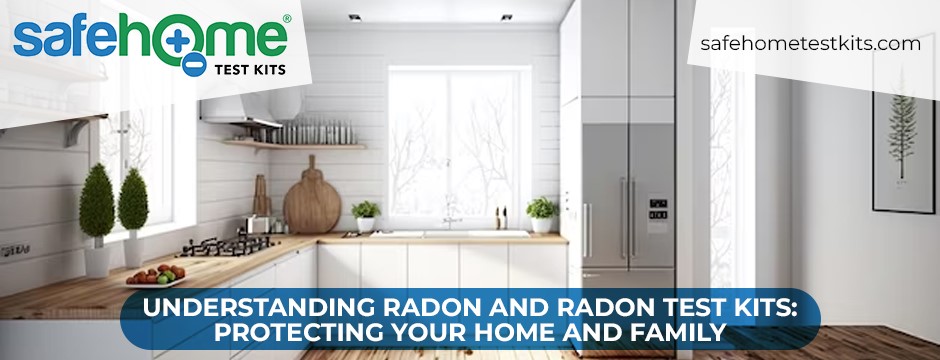Understanding Radon and Radon Test Kits: Protecting Your Home and Family

Invisible and odorless, radon is a naturally occurring radioactive gas that poses a serious health risk when it accumulates in enclosed spaces. The Environmental Protection Agency (EPA) states that radon is the second most common cause of lung cancer in the US. The only way to know if your home has elevated radon levels is through proper testing. In this particular blog, we will delve into the importance of radon testing, the significance of using a Radon Gas Test Kit, and how it can safeguard your home and family.
The Silent Threat: What is Radon?
Radon is a naturally occurring radioactive gas that forms from the decay of uranium in soil, rock, and water. It can enter homes through cracks and openings in the foundation, as well as through well water. Radon is colorless, odorless, and tasteless, making it virtually undetectable without proper testing.
Health Risks of Radon Exposure
The primary concern with radon is its potential to cause lung cancer. When radon gas is inhaled, it can break down into radioactive particles that can damage lung tissue. According to the U.S. Environmental Protection Agency (EPA), radon is the second leading cause of lung cancer in the United States, responsible for an estimated 21,000 deaths each year. Smokers exposed to radon have an even higher risk of developing lung cancer.

The Importance of Radon Testing
Given the serious health risks associated with radon exposure, testing for radon in your home is crucial. Testing with the Radon Testing Kit helps determine if radon levels are within acceptable limits or if mitigation measures are needed to reduce concentrations. There are various methods for radon testing, including short-term tests that provide results within a few days and long-term tests for a more accurate assessment over several months.
Short-Term vs. Long-Term Testing
Short-term radon tests are cost-effective and provide quick results, making them suitable for initial assessments. However, long-term testing is recommended for a more comprehensive understanding of radon levels, as they can fluctuate throughout the year. Long-term tests are particularly crucial in regions with seasonal variations in temperature and humidity.
Radon Testing Methods
Passive Testing
Passive radon testing involves using devices that do not require power to function. Charcoal canisters, alpha-track detectors, and charcoal liquid scintillation detectors are common passive testing methods. These devices absorb radon and its decay products, allowing for later analysis to determine the radon concentration.
Active Testing
Active radon testing involves powered devices that continuously monitor and record radon levels. Continuous radon monitors (CRMs) are commonly used for active testing, providing real-time data and a more detailed understanding of fluctuations in radon concentrations. Active testing is particularly useful for ongoing monitoring and ensuring the effectiveness of radon mitigation systems.
Radon Levels and Mitigation
Understanding Radon Levels
The unit of measurement for radon is picocuries per liter or pCi/L. The EPA recommends taking action if radon levels in your home exceed 4 pCi/L. However, any level of radon exposure carries some risk, so lower levels should not be ignored. Addressing elevated radon levels promptly is crucial to reducing the potential health risks for you and your family.
Radon Mitigation Techniques
If testing reveals elevated radon levels, mitigation measures are necessary to reduce concentrations. Common radon mitigation techniques include:
- Sub-Slab Depressurization: This method involves installing a pipe through the basement floor to vent radon gas safely outside, preventing it from entering the home.
- Ventilation Systems: Improving ventilation in crawl spaces or basements can help disperse radon gas, reducing its concentration within the home.
- Sealing Cracks and Openings: Properly sealing cracks in the foundation, walls, and floors can help prevent radon from entering the home.
- Well Water Aeration: In cases where radon enters the home through well water, aeration systems can be used to remove radon before it enters the home’s indoor air.
DIY Radon Testing vs. Professional Services
While there are many do-it-yourself radon testing kits available, hiring a professional radon testing service is often recommended for accurate and reliable results. Professionals have the expertise to ensure the proper placement of testing devices and can provide guidance on the most appropriate testing duration. Additionally, they can offer mitigation services if elevated radon levels are detected.
Protecting Your Home and Family
Understanding the radon threat and regularly testing your home with a radon gas test kit are vital steps in safeguarding your family’s health. If test results indicate elevated radon levels, it’s essential to implement effective mitigation measures. Radon mitigation systems, such as sub-slab depressurization and ventilation, can significantly reduce radon concentrations, creating a healthier living environment for you and your loved ones.

Safe Home® Radon Gas Test Kit – Premium: Ensuring Your Family's Safety
Radon, a silent and potentially deadly intruder, can infiltrate your home without warning, posing serious health risks. Safe Home® understands the gravity of this threat and presents the Radon Gas Test Kit – Premium at an affordable $14.95. This premium-grade kit is meticulously crafted to deliver precise and reliable results, offering peace of mind for you and your family.
Alarming statistics highlight radon as the leading cause of lung cancer among non-smokers in the USA, claiming over 20,000 lives annually. We acknowledge the urgency of diligent testing, providing a solution to identify this odorless and tasteless gas. The Radon Gas Test Kit – Premium is designed for hassle-free sample collection, ensuring that anyone can easily perform the test.
Our NRPP-certified lab, adhering to EPA-approved methods, ensures the reliability of the results. Homeowners, contractors, and home inspectors trust our expertise, with our lab maintaining NRPP certification in all 50 states for radon testing. This certification meets rigorous requirements for home inspections, mortgage approvals, and real estate transactions.
Buying a Radon Test Kit means opting for a quick and accurate short-term test lasting 2 to 4 days. We provide a seamless experience with text and email notifications, along with an online certified report. To further enhance your peace of mind, we offer free professional support, guiding you every step of the way and beyond the testing process.
For your convenience, we’ve streamlined the process with a modest online lab fee of $20 per sample. This charge is a cost-effective investment in the health of your family because it covers the expenses of routine testing and reporting services.
Don’t let radon lurk in the shadows, jeopardizing your well-being. With the Radon Gas Test Kits from Safe Home®, you can be proactive in safeguarding your loved ones. Your safety is our top priority, and with our premium kit, you can confidently secure a healthier living environment for your family.
Bottom Line
Radon testing is an essential step in safeguarding your home and family from the potential health risks associated with radon exposure. Understanding the testing methods, interpreting results, and implementing appropriate mitigation measures are key aspects of ensuring a healthy living environment. Whether you opt for a do-it-yourself Radon Gas Test Kit or seek the expertise of a certified professional, taking action to address radon concerns will contribute to the overall safety and well-being of your household. Don’t let the silent threat of radon compromise the air quality in your home—take proactive steps to protect your loved ones today.


